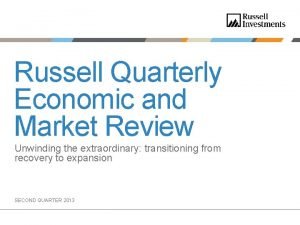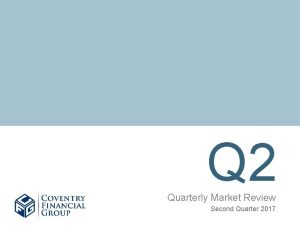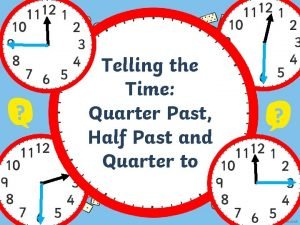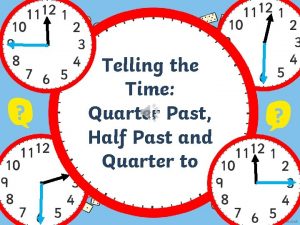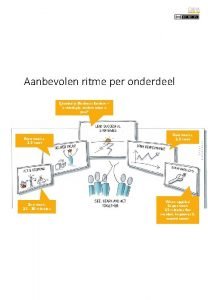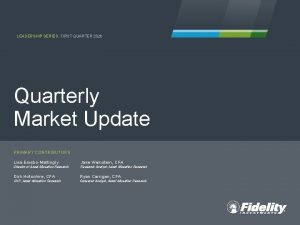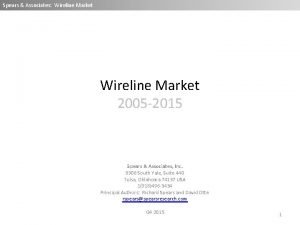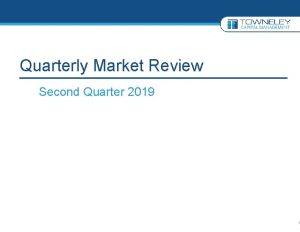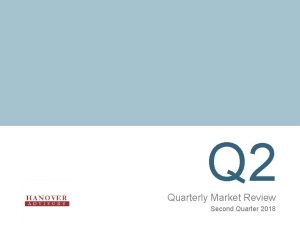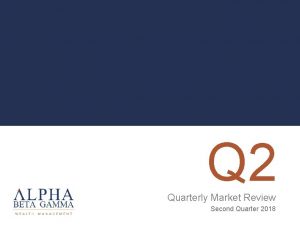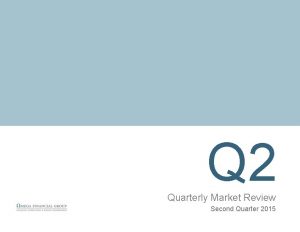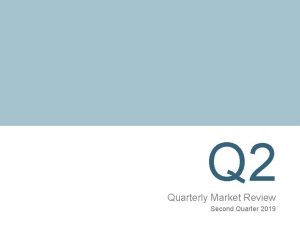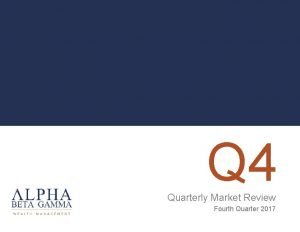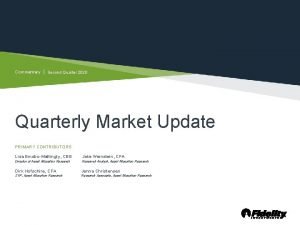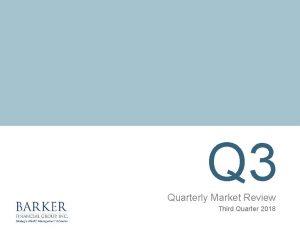Q 2 Quarterly Market Review Second Quarter 2017

















- Slides: 17

Q 2 Quarterly Market Review Second Quarter 2017

Quarterly Market Review Second Quarter 2017 This report features world capital market performance and a timeline of events for the past quarter. It begins with a global overview, then features the returns of stock and bond asset classes in the US and international markets. Overview: The report also illustrates the impact of globally diversified portfolios and features a quarterly topic. World Asset Classes Market Summary World Stock Market Performance US Stocks International Developed Stocks Emerging Markets Stocks Select Country Performance Select Currency Performance vs. US Dollar Real Estate Investment Trusts (REITs) Commodities Fixed Income Impact of Diversification Quarterly Topic: When Rates Go Up, Do Stocks Go Down?

Market Summary Index Returns Past performance is not a guarantee of future results. Indices are not available for direct investment. Index performance does not reflect the expenses associated with the management of an actual portfolio. Market segment (index representation) as follows: US Stock Market (Russell 3000 Index), International Developed Stocks (MSCI World ex USA Index [net div. ]), Emerging Markets (MSCI Emerging Markets Index [net div. ]), Global Real Estate (S&P Global REIT Index [net div. ]), US Bond Market (Bloomberg Barclays US Aggregate Bond Index), and Global Bond ex US Market (Citi WGBI ex USA 1− 30 Years [Hedged to USD]). The S&P data are provided by Standard & Poor's Index Services Group. Frank Russell Company is the source and owner of the trademarks, service marks, and copyrights related to the Russell Indexes. MSCI data © MSCI 2017, all rights reserved. Bloomberg Barclays data provided by Bloomberg. Citi fixed income indices copyright 2017 by Citigroup. 3

World Stock Market Performance MSCI All Country World Index with selected headlines from Q 2 2017 “Nasdaq Soars to New Heights as Global Stocks Rally” “UK Economy Slows Sharply Ahead of Election, Brexit Talks” “Eurozone House Prices Rise at Fastest Pace since 2007” “Eurozone Confidence Hits Postcrisis High” “US Household Debt Hit Record in First Quarter” “Home Sales Jump to Near. Boom-Era Levels” “US Job Openings Hit New High” “Japan’s Growth Winning Streak Is Longest in Over a Decade” “New-Home Sales Rise in May as Prices Hit Record Level” “IMF Lowers Forecast for US Economy Amid Rising Policy Uncertainty” “Global Stocks Post Strongest First Half in Years, Worrying Investors” “IMF Upgrades UK 2017, 2018 Growth Forecast as Brexit Fears Ease” Apr “Eurozone Consumer Confidence at Highest Level in Nearly a Decade” “Unemployment “Global Bonds Sell Off, Rate Falls to 16 Sparking Fears of Further Year Low, but ‘Taper Tantrum’” Hiring Slows” “US Oil Falls into Bear Market Amid Worries Over Supply Glut” May Jun These headlines are not offered to explain market returns. Instead, they serve as a reminder that investors should view daily events from a long-term perspective and avoid making investment decisions based solely on the news. Graph Source: MSCI ACWI Index [net div. ]. MSCI data © MSCI 2017, all rights reserved. It is not possible to invest directly in an index. Performance does not reflect the expenses associated with management of an actual portfolio. Past performance is not a guarantee of future results. 4

World Stock Market Performance MSCI All Country World Index with selected headlines from past 12 months Short Term (Q 3 2016–Q 2 2017) “US Household Debt Hit Record in First Quarter” “US Consumer Confidence Reaches Highest Level since 2000” “Unemployment Rate Falls to 16 -Year Low, But Hiring Slows” 230 “World Trade Set For Slowest Yearly Growth since Global Financial Crisis” 220 210 “China’s Export Decline Accelerates” “US New Home Sales Rise to Highest Level since 2007” 200 “Global Inflation Falls to Seven. Year Low” Long Term Last 12 months (2000–Q 2 2017) 250. 00 200. 00 150. 00 170 “Global Stocks Post Strongest First Half in Years, Worrying Investors” “Trump Wins” “Cyberattack Knocks Out Access to Websites” 190 180 “Pound Drops to 31 -Year Low Against Dollar” “US Trade Deficit Last Year Was Widest since 2012” “Donald Trump Sworn in as 45 th US President” “Consumer Confidence Hits Highest Level since 2001” “Eurozone Confidence Hits Postcrisis High” “Fed Raises Interest Rates, Remains on Track to Keep Tightening” 100. 00 50. 00 160 Jun-2016 0. 00 2000 Sep-2016 Dec-2016 Mar-2017 Jun-2017 These headlines are not offered to explain market returns. Instead, they serve as a reminder that investors should view daily events from a long-term perspective and avoid making investment decisions based solely on the news. Graph Source: MSCI ACWI Index [net div. ]. MSCI data © MSCI 2017, all rights reserved. It is not possible to invest directly in an index. Performance does not reflect the expenses associated with management of an actual portfolio. Past performance is not a guarantee of future results. 5

World Asset Classes Second Quarter 2017 Index Returns (%) Looking at broad market indices, non-US developed markets and emerging markets recorded similar returns, outperforming the US during the quarter. The value effect was negative in the US, non-US, and emerging markets. Small caps outperformed large caps in non-US developed markets but underperformed in the US and emerging markets. MSCI World ex USA Small Cap Index (net div. ) 7. 28 MSCI Emerging Markets Index (net div. ) 6. 27 MSCI All Country World ex USA Index (net div. ) 5. 78 MSCI World ex USA Index (net div. ) 5. 63 MSCI World ex USA Value Index (net div. ) 4. 36 MSCI Emerging Markets Value Index (net div. ) 3. 17 S&P 500 Index 3. 09 Russell 1000 Index 3. 06 Russell 3000 Index 3. 02 MSCI Emerging Markets Small Cap Index (net div. ) 2. 63 S&P Global ex US REIT Index (net div. ) 2. 58 Russell 2000 Index 2. 46 Dow Jones US Select REIT Index 1. 64 Bloomberg Barclays US Aggregate Bond Index 1. 45 Russell 1000 Value Index 1. 34 Russell 2000 Value Index One-Month US Treasury Bills 0. 67 0. 18 Past performance is not a guarantee of future results. Indices are not available for direct investment. Index performance does not reflect the expenses associated with the management of an actual portfolio. The S&P data is provided by Standard & Poor's Index Services Group. Frank Russell Company is the source and owner of the trademarks, service marks, and copyrights related to the Russell Indexes. MSCI data © MSCI 2017, all rights reserved. Dow Jones data (formerly Dow Jones Wilshire) provided by Dow Jones Indices. Bloomberg Barclays data provided by Bloomberg. Treasury bills © Stocks, Bonds, Bills, and Inflation Yearbook™, Ibbotson Associates, Chicago (annually updated work by Roger G. Ibbotson and Rex A. Sinquefield). 6

US Stocks Second Quarter 2017 Index Returns The broad US equity market posted positive returns for the quarter but underperformed both non-US developed and emerging markets. Value underperformed growth indices in the US across all size ranges. Small caps in the US underperformed large caps. Ranked Returns for the Quarter (%) Large Growth 4. 67 Small Growth 4. 39 Large Cap 3. 06 Marketwide 3. 02 Small Cap 2. 46 Large Value Small Value 1. 34 0. 67 World Market Capitalization—US 52% US Market $25. 1 trillion Past performance is not a guarantee of future results. Indices are not available for direct investment. Index performance does not reflect the expenses associated with the management of an actual portfolio. Market segment (index representation) as follows: Marketwide (Russell 3000 Index), Large Cap (Russell 1000 Index), Large Cap Value (Russell 1000 Value Index), Large Cap Growth (Russell 1000 Growth Index), Small Cap (Russell 2000 Index), Small Cap Value (Russell 2000 Value Index), and Small Cap Growth (Russell 2000 Growth Index). World Market Cap represented by Russell 3000 Index, MSCI World ex USA IMI Index, and MSCI Emerging Markets IMI Index. Russell 3000 Index is used as the proxy for the US market. Frank Russell Company is the source and owner of the trademarks, service marks, and copyrights related to the Russell Indexes. MSCI data © MSCI 2017, all rights reserved. 7

International Developed Stocks Second Quarter 2017 Index Returns In US dollar terms, developed markets outperformed the US equity market and had similar performance to emerging markets indices during the quarter. Looking at broad market indices, the value effect was negative across all size ranges in non-US developed markets. Small caps outperformed large caps in non-US developed markets. Ranked Returns (%) Local currency 4. 29 Small Cap 7. 28 3. 63 Growth 6. 98 2. 30 Large Cap Value US currency 5. 63 1. 05 4. 36 World Market Capitalization—International Developed 36% International Developed Market $17. 5 trillion Past performance is not a guarantee of future results. Indices are not available for direct investment. Index performance does not reflect the expenses associated with the management of an actual portfolio. Market segment (index representation) as follows: Large Cap (MSCI World ex USA Index), Small Cap (MSCI World ex USA Small Cap Index), Value (MSCI World ex USA Value Index), and Growth (MSCI World ex USA Growth). All index returns are net of withholding tax on dividends. World Market Cap represented by Russell 3000 Index, MSCI World ex USA IMI Index, and MSCI Emerging Markets IMI Index. MSCI World ex USA IMI Index is used as the proxy for the International Developed market. MSCI data © MSCI 2017, all rights reserved. Frank Russell Company is the source and owner of the trademarks, service marks, and copyrights related to the Russell Indexes. 8

Emerging Markets Stocks Second Quarter 2017 Index Returns In US dollar terms, emerging markets indices outperformed the US and recorded similar performance to developed markets outside the US. Looking at broad market indices, the value effect was negative across all size ranges in emerging markets. Ranked Returns (%) Local currency 9. 72 9. 44 Growth 6. 56 6. 27 Large Cap Small caps underperformed large caps in emerging markets. Value Small Cap US currency 3. 48 3. 17 2. 72 2. 63 World Market Capitalization—Emerging Markets 11% Emerging Markets $5. 4 trillion Past performance is not a guarantee of future results. Indices are not available for direct investment. Index performance does not reflect the expenses associated with the management of an actual portfolio. Market segment (index representation) as follows: Large Cap (MSCI Emerging Markets Index), Small Cap (MSCI Emerging Markets Small Cap Index), Value (MSCI Emerging Markets Value Index), and Growth (MSCI Emerging Markets Growth Index). All index returns are net of withholding tax on dividends. World Market Cap represented by Russell 3000 Index, MSCI World ex USA IMI Index, and MSCI Emerging Markets IMI Index used as the proxy for the emerging market portion of the market. MSCI data © MSCI 2017, all rights reserved. Frank Russell Company is the source and owner of the trademarks, service marks, and copyrights related to the Russell Indexes. 9

Select Country Performance Second Quarter 2017 Index Returns In US dollar terms, Austria and Denmark recorded the highest country performance in developed markets, while Australia and Canada posted the lowest returns for the quarter. In emerging markets, Greece, Hungary, and Turkey posted the highest country returns, while Qatar and Russia had the lowest performance. Ranked Developed Markets Returns (%) Austria Denmark Finland New Zealand France Italy Switzerland Sweden Netherlands Portugal Spain Germany Hong Kong Israel Ireland Japan UK Singapore Belgium Norway US Canada Australia Ranked Emerging Markets Returns (%) 18. 39 15. 14 13. 28 11. 70 9. 54 9. 48 9. 29 9. 13 8. 20 7. 73 7. 72 6. 99 6. 79 6. 18 5. 52 5. 41 5. 13 4. 88 4. 79 3. 15 2. 83 0. 48 -1. 43 Greece Hungary Turkey Poland South Korea Czech Republic China Taiwan Mexico Peru Indonesia Philippines Malaysia India South Africa Egypt Thailand Colombia UAE Chile Brazil Russia Qatar 34. 11 18. 88 13. 46 9. 75 9. 26 7. 74 7. 36 7. 08 6. 52 6. 11 5. 58 3. 66 2. 59 2. 27 2. 12 1. 80 1. 00 -2. 28 -6. 37 -9. 87 -11. 23 Past performance is not a guarantee of future results. Indices are not available for direct investment. Index performance does not reflect the expenses associated with the management of an actual portfolio. Country performance based on respective indices in the MSCI World ex US IMI Index (for developed markets), MSCI USA IMI Index (for US), and MSCI Emerging Markets IMI Index. All returns in USD and net of withholding tax on dividends. MSCI data © MSCI 2017, all rights reserved. UAE and Qatar have been reclassified as emerging markets by MSCI, effective May 2014. 10

Select Currency Performance vs. US Dollar Second Quarter 2017 Most non-US developed currencies appreciated against the US dollar during the quarter, with the Danish krone and the euro experiencing the biggest gains. Emerging markets currencies were mixed vs. the US dollar. The Czech koruna appreciated by more than 10%, while the Russian ruble, Brazilian real, and Columbian peso depreciated by more than 4%. Ranked Developed Markets (%) Ranked Emerging Markets (%) Danish krone (DKK) 6. 66 Euro (EUR) 6. 64 Swedish krona (SEK) 5. 85 New Zealand dollar (NZD) 4. 74 Swiss franc (CHF) 4. 52 Czech koruna (CZK) 10. 35 Poland new zloty (PLZ) 6. 84 Hungary forint (HUF) 6. 54 4. 06 Mexican peso (MXP) Turkish new lira (TRY) 3. 38 Malaysian ringgit (MYR) 3. 09 South African rand (ZAR) 2. 34 Chinese yuan (CNY) Israel shekel (ILS) 4. 03 British pound (GBP) 3. 88 Canadian dollar (CAD) Norwegian krone (NOK) Singapore dollar (SGD) 0. 55 Thailand baht (THB) 1. 16 Indian rupee (INR) 0. 46 Peru new sol (PEI) 0. 12 2. 69 Indonesian rupiah (IDR) -0. 02 2. 53 Taiwanese NT dollar (TWD) -0. 25 Egyptian pound (EGP) -0. 39 1. 49 Australian dollar (AUD) 1. 66 Chilean peso (CLP) -0. 39 Philippine peso (PHP) -0. 56 -2. 26 South Korean won (KRW) Hong Kong dollar (HKD) Japanese yen (JPY) -0. 45 -0. 83 Brazilian real (BRC) -4. 17 Russian ruble (RUB) -4. 94 Colombian peso (COP) -5. 28 Past performance is not a guarantee of future results. Indices are not available for direct investment. Index performance does not reflect the expenses associated with the management of an actual portfolio. MSCI data © MSCI 2017, all rights reserved. 11

Real Estate Investment Trusts (REITs) Second Quarter 2017 Index Returns Non-US real estate investment trusts outperformed US REITs. Ranked Returns (%) Global REITs (ex US) US REITs 2. 58 1. 64 Total Value of REIT Stocks 40% World ex US $449 billion 264 REITs (22 other countries) 60% US $661 billion 106 REITs Past performance is not a guarantee of future results. Indices are not available for direct investment. Index performance does not reflect the expenses associated with the management of an actual portfolio. Number of REIT stocks and total value based on the two indices. All index returns are net of withholding tax on dividends. Total value of REIT stocks represented by Dow Jones US Select REIT Index and the S&P Global ex US REIT Index. Dow Jones US Select REIT Index used as proxy for the US market, and S&P Global ex US REIT Index used as proxy for the World ex US market. Dow Jones US Select REIT Index data provided by Dow Jones ©. S&P Global ex US REIT Index data provided by Standard and Poor's Index Services Group © 2017. 12

Commodities Second Quarter 2017 Index Returns The Bloomberg Commodity Index Total Return declined 3. 00% during the second quarter. Ranked Returns for Individual Commodities (%) Kansas wheat The livestock and grains complexes led quarterly performance, with lean hogs returning 14. 44%, live cattle 8. 59%, wheat (Chicago) 15. 95%, and wheat (Kansas) 17. 82%. Softs was the worst-performing complex, with sugar and coffee declining 18. 76% and 12. 79%, respectively. Cotton also experienced a decline, decreasing 9. 44%. 17. 82 Wheat 15. 95 14. 44 Lean hogs Live cattle 8. 59 Soybean oil 2. 58 Copper 1. 17 Corn 0. 53 Soybeans -0. 91 Gold -0. 99 Zinc -1. 05 Soybean meal -1. 89 Aluminum -2. 93 Nickel -6. 90 Heating oil -7. 46 Cotton -9. 44 Natural gas -9. 60 Silver -9. 69 Brent oil -10. 41 Unleaded gas -10. 51 WTI crude oil -10. 68 Coffee Sugar -12. 79 -18. 76 Past performance is not a guarantee of future results. Index is not available for direct investment. Index performance does not reflect the expenses associated with the management of an actual portfolio. All index returns are net of withholding tax on dividends. Securities and commodities data provided by Bloomberg. 13

Fixed Income Second Quarter 2017 Index Returns Interest rates were mixed across the US fixed income market during the second quarter. The yield on the 5 -year Treasury note decreased 4 basis points (bps) to 1. 89%. The yield on the 10 -year Treasury note decreased 9 bps to 2. 31%. The 30 year Treasury bond yield decreased 18 bps to finish at 2. 84%. The yield on the 1 -year Treasury bill rose 21 bps to 1. 24%, and the 2 -year Treasury note yield rose 11 bps to 1. 38%. The yield on the 3 -month Treasury bill climbed 27 bps to 1. 03%, while the 6 -month Treasury bill yield increased 23 bps to 1. 14%. US Treasury Yield Curve (%) Bond Yields across Issuers (%) 4 42825 42916 42551 3 2 2. 95 2. 31 3. 32 2. 73 1 0 1 Yr 5 Yr 10 Yr 30 Yr 10 -Year US Treasury Municipals AAA-AA Corporates A-BBB Corporates In terms of total returns, short-term corporate bonds gained 0. 59% and intermediate corporates gained 1. 49%. Short-term municipal bonds gained 0. 56%, while intermediate-term municipal bonds returned 1. 97%. Revenue bonds gained 2. 19%, outperforming general obligation bonds by 39 bps. One basis point equals 0. 01%. Past performance is not a guarantee of future results. Indices are not available for direct investment. Index performance does not reflect the expenses associated with the management of an actual portfolio. Yield curve data from Federal Reserve. State and local bonds are from the S&P National AMT-Free Municipal Bond Index. AAA-AA Corporates represent the Bank of America Merrill Lynch US Corporates, AA-AAA rated. A-BBB Corporates represent the Bank of America Merrill Lynch US Corporates, BBB-A rated. Bloomberg Barclays data provided by Bloomberg. US long-term bonds, bills, inflation, and fixed income factor data © Stocks, Bonds, Bills, and Inflation (SBBI) Yearbook™, Ibbotson Associates, Chicago (annually updated work by Roger G. Ibbotson and Rex A. Sinquefield). Citi fixed income indices copyright 2017 by Citigroup. The Bof. A Merrill Lynch Indices are used with permission; © 2017 Merrill Lynch, Pierce, Fenner & Smith Incorporated; all rights reserved. Merrill Lynch, Pierce, Fenner & Smith Incorporated is a wholly owned subsidiary of Bank of America Corporation. The S&P data are provided by Standard & Poor's Index Services Group. 14

Impact of Diversification Second Quarter 2017 Index Returns These portfolios illustrate the performance of different global stock/bond mixes. Mixes with larger allocations to stocks are considered riskier but have higher expected returns over time. Ranked Returns (%) 100% Stocks 4. 45 75/25 3. 38 50/50 2. 30 25/75 100% Treasury Bills 1. 24 0. 18 Growth of Wealth: The Relationship between Risk and Return Stock/Bond Mix $100, 000 100% Stocks $80, 000 75/25 $60, 000 50/50 $40, 000 25/75 100% Treasury Bills $20, 000 $0 12/1988 12/1993 12/1998 12/2003 12/2008 12/2013 6/2017 1. STDEV (standard deviation) is a measure of the variation or dispersion of a set of data points. Standard deviations are often used to quantify the historical return volatility of a security or portfolio. Diversification does not eliminate the risk of market loss. Past performance is not a guarantee of future results. Indices are not available for direct investment. Index performance does not reflect expenses associated with the management of an actual portfolio. Asset allocations and the hypothetical index portfolio returns are for illustrative purposes only and do not represent actual performance. Global Stocks represented by MSCI All Country World Index (gross div. ) and Treasury Bills represented by US One-Month Treasury Bills. Globally diversified allocations rebalanced monthly, no withdrawals. Data © MSCI 2017, all rights reserved. Treasury bills © Stocks, Bonds, Bills, and Inflation Yearbook™, Ibbotson Associates, Chicago (annually updated work by Roger G. Ibbotson and Rex A. Sinquefield). 15

When Rates Go Up, Do Stocks Go Down? Second Quarter 2017 Should stock investors worry about changes in interest rates? Exhibit 1. Monthly US Stock Returns against Monthly Changes in Effective Federal Funds Rate, August 1954–December 2016 Research shows that, like stock prices, changes in interest rates and bond prices are largely unpredictable. 1 It follows that an investment strategy based upon attempting to exploit these sorts of changes isn’t likely to be a fruitful endeavor. Despite the unpredictable nature of interest rate changes, investors may still be curious about what might happen to stocks if interest rates go up. Unlike bond prices, which tend to go down when yields go up, stock prices might rise or fall with changes in interest rates. For stocks, it can go either way because a stock’s price depends on both future cash flows to investors and the discount rate they apply to those expected cash flows. When interest rates rise, the discount rate may increase, which in turn could cause the price of the stock to fall. However, it is also possible that when interest rates change, expectations about future cash flows expected from holding a stock also change. So, if theory doesn’t tell us what the overall effect should be, the next question is what does the data say? Recent Research Recent research performed by Dimensional Fund Advisors helps provide insight into this question. 2 The research examines the correlation between monthly US stock returns and changes in interest rates. 3 Exhibit 1 shows that while there is a lot of noise in stock returns and no clear pattern, not much of that variation appears to be related to changes in the effective federal funds rate. 4 Monthly US stock returns are defined as the monthly return of the Fama/French Total US Market Index and are compared to contemporaneous monthly changes in the effective federal funds rate. Bond yield changes are obtained from the Federal Reserve Bank of St. Louis. 1. See, for example, Fama 1976, Fama 1984, Fama and Bliss 1987, Campbell and Shiller 1991, and Duffee 2002. 2. Wei Dai, “Interest Rates and Equity Returns” (Dimensional Fund Advisors, April 2017). 3. US stock market defined as Fama/French Total US Market Index. 4. The federal funds rate is the interest rate at which depository institutions lend funds maintained at the Federal Reserve to another depository institution overnight. 16

When Rates Go Up, Do Stocks Go Down? (continued from page 16) For example, in months when the federal funds rate rose, stock returns were as low as – 15. 56% and as high as 14. 27%. In months when rates fell, returns ranged from – 22. 41% to 16. 52%. Given that there are many other interest rates besides just the federal funds rate, Dai also examined longer-term interest rates and found similar results. So to address our initial question: when rates go up, do stock prices go down? The answer is yes, but only about 40% of the time. In the remaining 60% of months, stock returns were positive. This split between positive and negative returns was about the same when examining all months, not just those in which rates went up. In other words, there is not a clear link between stock returns and interest rate changes. CONCLUSION There’s no evidence that investors can reliably predict changes in interest rates. Even with perfect knowledge of what will happen with future interest rate changes, this information provides little guidance about subsequent stock returns. Instead, staying invested and avoiding the temptation to make changes based on short-term predictions may increase the likelihood of consistently capturing what the stock market has to offer. GLOSSARY Discount Rate: Also known as the “required rate of return, ” this is the expected return investors demand for holding a stock. Correlation: A statistical measure that indicates the extent to which two variables are related or move together. Correlation is positive when two variables tend to move in the same direction and negative when they tend to move in opposite directions. INDEX DESCRIPTIONS Fama/French Total US Market Index: Provided by Fama/French from CRSP securities data. Includes all US operating companies trading on the NYSE, AMEX, or Nasdaq NMS. Excludes ADRs, investment companies, tracking stocks, non-US incorporated companies, closed-end funds, certificates, shares of beneficial interests, and Berkshire Hathaway Inc. (Permco 540). Source: Dimensional Fund Advisors LP. Results shown during periods prior to each Index’s index inception date do not represent actual returns of the respective index. Other periods selected may have different results, including losses. Backtested index performance is hypothetical and is provided for informational purposes only to indicate historical performance had the index been calculated over the relevant time periods. Backtested performance results assume the reinvestment of dividends and capital gains. Eugene Fama and Ken French are members of the Board of Directors for and provide consulting services to Dimensional Fund Advisors LP. There is no guarantee investment strategies will be successful. Investing involves risks including possible loss of principal. All expressions of opinion are subject to change. This article is distributed for informational purposes, and it is not to be construed as an offer, solicitation, recommendation, or endorsement of any particular security, products, or services. 17
 Russell quarterly economic and market review
Russell quarterly economic and market review Russell quarterly economic and market review
Russell quarterly economic and market review Quarter 3 time
Quarter 3 time Quarter past 7
Quarter past 7 Quarterly business review examples
Quarterly business review examples Quarterly business review template
Quarterly business review template Quarterly business review templates
Quarterly business review templates Quarterly business review
Quarterly business review Fidelity quarterly market update q1 2018
Fidelity quarterly market update q1 2018 Second quarter exam
Second quarter exam Market follower
Market follower Segmenting targeting and positioning
Segmenting targeting and positioning 186 282 miles per second into meters per second
186 282 miles per second into meters per second Spears and associates
Spears and associates Walkenhorst inmate packages
Walkenhorst inmate packages Gantt chart template quarterly
Gantt chart template quarterly Kpi measurement template
Kpi measurement template Early childhood research quarterly submission guidelines
Early childhood research quarterly submission guidelines
